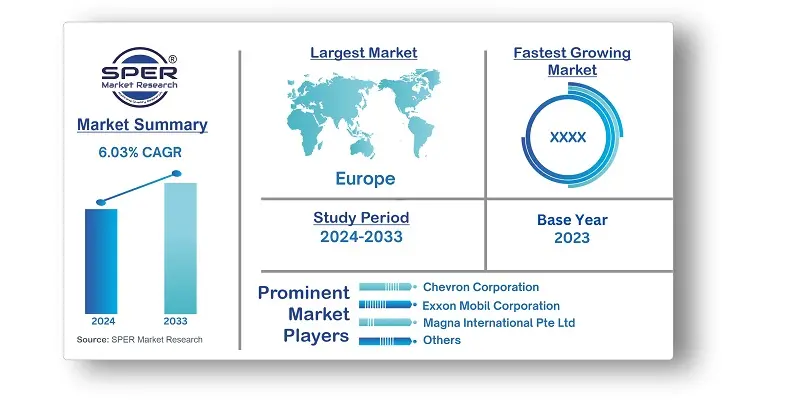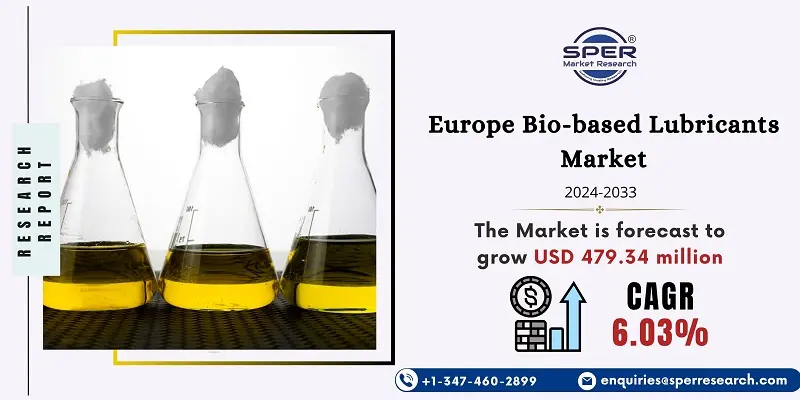
Europe Bio-based Lubricants Market Growth, Size, Trends, Demand, Share and Future Outlook
Europe Bio-based Lubricants Market Size- By Raw Material, By Application, By End User Industry- Regional Outlook, Competitive Strategies and Segment Forecast to 2033
| Published: Jul-2024 | Report ID: CHEM2476 | Pages: 1 - 159 | Formats*: |
| Category : Chemical & Materials | |||
- In 2022, ExxonMobil increased its focus on biofuels in an effort to reduce greenhouse gas emissions associated with transportation. They acquired a 49.9% stake in Biojet AS, a biofuels business located in Norway that produces low-emission biofuels and biofuel components including lubricants and diesel from wood-based construction waste and forestry.
- In 2022, Castrol introduced BioTac MP2, an all-purpose extreme pressure grease with several uses for exposed deck applications, including wire ropes and low-speed bearings.


| Report Metric | Details |
| Market size available for years | 2020-2033 |
| Base year considered | 2023 |
| Forecast period | 2024-2033 |
| Segments covered | By Raw Material, By Application, By End User Industry |
| Regions covered | Germany, France, Italy, UK, Russia, and the Rest of Europe. |
| Companies Covered | Shell group of companies, BP, Chevron Corporation, Exxon Mobil Corporation, CASTROL LIMITED, FUCHS, Green Earth Technologies Inc., Magna International Pte Ltd, Polnox Corp, KLÃœBER LUBRICATION INDIA Pvt Ltd, MMXIX DSI Ventures Inc., Biosynthetic Technologies, Mitsubishi Chemical Corporation, Novozymes, BASF SE. |
- Automotive Manufacturers
- Industrial Machinery Manufacturers
- Marine and Aviation Sectors
- Agricultural Equipment Manufacturers
- Renewable Energy Sector
- Government and Regulatory Bodies
- Environmental Organizations
- Lubricant Distributors and Retailers
| By Raw Material: |
|
| By Application: |
|
| By End User Industry: |
|
- Europe Bio-based Lubricants Market Size (FY’2024-FY’2033)
- Overview of Europe Bio-based Lubricants Market
- Segmentation of Europe Bio-based Lubricants Market By Raw Material (Plant Oil, Animal Oil, Others)
- Segmentation of Europe Bio-based Lubricants Market By Application (Hydraulic Oil, Metal Working Fluids, Penetrating Oils, Grease, Transformer Oil, Crankcase Oils Engine Oils, Elevator Hydraulic Fluid, Bar and Chain Oil, Firearm Lubricant, Others)
- Segmentation of Europe Bio-based Lubricants Market By End User Industry (Power Generation, Automotive and Other Transportation, Heavy Equipment, Food and Beverage, Metallurgy and Metalworking, Chemical Manufacturing, Other End-user Industries)
- Statistical Snap of Europe Bio-based Lubricants Market
- Expansion Analysis of Europe Bio-based Lubricants Market
- Problems and Obstacles in Europe Bio-based Lubricants Market
- Competitive Landscape in the Europe Bio-based Lubricants Market
- Impact of COVID-19 and Demonetization on Europe Bio-based Lubricants Market
- Details on Current Investment in Europe Bio-based Lubricants Market
- Competitive Analysis of Europe Bio-based Lubricants Market
- Prominent Players in the Europe Bio-based Lubricants Market
- SWOT Analysis of Europe Bio-based Lubricants Market
- Europe Bio-based Lubricants Market Future Outlook and Projections (FY’2024-FY’2033)
- Recommendations from Analyst
1.1. Scope of the report1.2. Market segment analysis
2.1. Research data source
2.1.1. Secondary Data2.1.2. Primary Data2.1.3. SPER’s internal database2.1.4. Premium insight from KOL’s
2.2. Market size estimation
2.2.1. Top-down and Bottom-up approach
2.3. Data triangulation
4.1. Driver, Restraint, Opportunity and Challenges analysis
4.1.1. Drivers4.1.2. Restraints4.1.3. Opportunities4.1.4. Challenges
4.2. COVID-19 Impacts of the Europe Bio-based Lubricants Market
5.1. SWOT Analysis
5.1.1. Strengths5.1.2. Weaknesses5.1.3. Opportunities5.1.4. Threats
5.2. PESTEL Analysis
5.2.1. Political Landscape5.2.2. Economic Landscape5.2.3. Social Landscape5.2.4. Technological Landscape5.2.5. Environmental Landscape5.2.6. Legal Landscape
5.3. PORTER’s Five Forces
5.3.1. Bargaining power of suppliers5.3.2. Bargaining power of buyers5.3.3. Threat of Substitute5.3.4. Threat of new entrant5.3.5. Competitive rivalry
5.4. Heat Map Analysis
6.1. Europe Bio-based Lubricants Market Manufacturing Base Distribution, Sales Area, Product Type6.2. Mergers & Acquisitions, Partnerships, Product Launch, and Collaboration in Europe Bio-based Lubricants Market
7.1. Europe Bio-based Lubricants Market Size, Share and Forecast, By Raw Material, 2020-20267.2. Europe Bio-based Lubricants Market Size, Share and Forecast, By Raw Material, 2027-20337.3. Plant Oil7.4. Animal Oil7.5. Others
8.1. Europe Bio-based Lubricants Market Size, Share and Forecast, By Application, 2020-20268.2. Europe Bio-based Lubricants Market Size, Share and Forecast, By Application, 2027-20338.3. Hydraulic Oil8.4. Metal Working Fluids8.5. Penetrating Oils8.6. Grease8.7. Transformer Oil8.8. Crankcase Oils Engine Oils8.9. Elevator Hydraulic Fluid8.10. Bar and Chain Oil8.11. Firearm Lubricant8.12. Others
9.1. Europe Bio-based Lubricants Market Size, Share and Forecast, By End User Industry, 2020-20269.2. Europe Bio-based Lubricants Market Size, Share and Forecast, By End User Industry, 2027-20339.3. Power Generation9.4. Automotive and Other Transportation9.5. Heavy Equipment9.6. Food and Beverage9.7. Metallurgy and Metalworking9.8. Chemical Manufacturing9.9. Other End-user Industries
10.1. Europe Bio-based Lubricants Market Size and Market Share
11.1. Europe Bio-based Lubricants Market Size and Market Share By Region (2020-2026)11.2. Europe Bio-based Lubricants Market Size and Market Share By Region (2027-2033)11.3. Germany11.4. France11.5. Italy11.6. UK11.7. Russia11.8. Rest of Europe
12.1. Shell group of companies
12.1.1. Company details12.1.2. Financial outlook12.1.3. Product summary12.1.4. Recent developments
12.2. BP
12.2.1. Company details12.2.2. Financial outlook12.2.3. Product summary12.2.4. Recent developments
12.3. Chevron Corporation
12.3.1. Company details12.3.2. Financial outlook12.3.3. Product summary12.3.4. Recent developments
12.4. Exxon Mobil Corporation
12.4.1. Company details12.4.2. Financial outlook12.4.3. Product summary12.4.4. Recent developments
12.5. CASTROL LIMITED
12.5.1. Company details12.5.2. Financial outlook12.5.3. Product summary12.5.4. Recent developments
12.6. FUCHS
12.6.1. Company details12.6.2. Financial outlook12.6.3. Product summary12.6.4. Recent developments
12.7. Green Earth Technologies, Inc
12.7.1. Company details12.7.2. Financial outlook12.7.3. Product summary12.7.4. Recent developments
12.8. Magna International Pte Ltd
12.8.1. Company details12.8.2. Financial outlook12.8.3. Product summary12.8.4. Recent developments
12.9. Polnox Corp
12.9.1. Company details12.9.2. Financial outlook12.9.3. Product summary12.9.4. Recent developments
12.10. KLÃœBER LUBRICATION INDIA Pvt. Ltd
12.10.1. Company details12.10.2. Financial outlook12.10.3. Product summary12.10.4. Recent developments
12.11. MMXIX DSI Ventures, Inc
12.11.1. Company details12.11.2. Financial outlook12.11.3. Product summary12.11.4. Recent developments
12.12. Biosynthetic Technologies
12.12.1. Company details12.12.2. Financial outlook12.12.3. Product summary12.12.4. Recent developments
12.13. Mitsubishi Chemical Corporation
12.13.1. Company details12.13.2. Financial outlook12.13.3. Product summary12.13.4. Recent developments
12.14. BASF SE
12.14.1. Company details12.14.2. Financial outlook12.14.3. Product summary12.14.4. Recent developments
12.15. Others
SPER Market Research’s methodology uses great emphasis on primary research to ensure that the market intelligence insights are up to date, reliable and accurate. Primary interviews are done with players involved in each phase of a supply chain to analyze the market forecasting. The secondary research method is used to help you fully understand how the future markets and the spending patterns look likes.
The report is based on in-depth qualitative and quantitative analysis of the Product Market. The quantitative analysis involves the application of various projection and sampling techniques. The qualitative analysis involves primary interviews, surveys, and vendor briefings. The data gathered as a result of these processes are validated through experts opinion. Our research methodology entails an ideal mixture of primary and secondary initiatives.



Frequently Asked Questions About This Report
PLACE AN ORDER
Year End Discount
Sample Report
Pre-Purchase Inquiry
NEED CUSTOMIZATION?
Request CustomizationCALL OR EMAIL US
100% Secure Payment






Related Reports
Our Global Clients
Our data-driven insights have influenced the strategy of 200+ reputed companies across the globe.






















